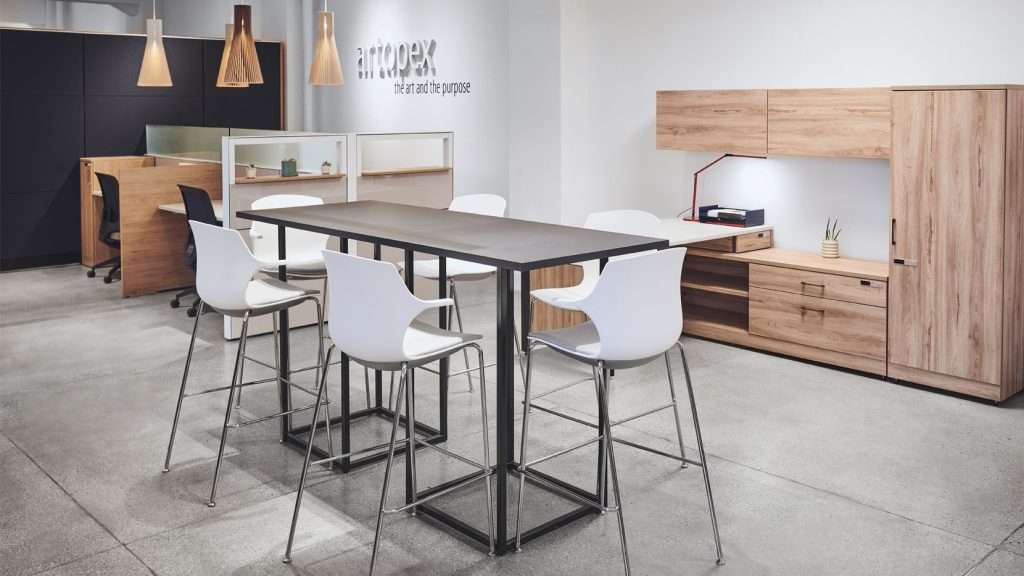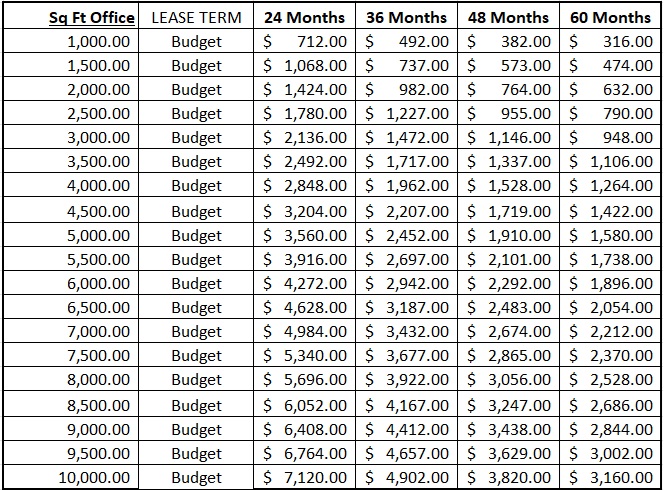Office Furniture in Las Vegas for Small Businesses
Welcome, small business owners! If you’re in the midst of setting up your office or thinking about a revamp, you’ve landed in the right place. Choosing the right office furniture is not just about aesthetics; it’s about creating an environment that fosters productivity, comfort, and well-being. In this comprehensive guide, we’ll explore everything you need to know to make informed decisions about your office furnishings. From the importance of furniture in setting the tone for your workspace to the impact it has on employee productivity, we’ve got you covered. Let’s dive in!
Navigating the world of office furniture can be a daunting task, especially for small businesses where every decision can have a significant impact. The furniture you choose is not merely a functional part of the office; it plays a critical role in shaping the office culture, enhancing employee morale, and even attracting clients. It’s essential to strike the right balance between cost, functionality, and aesthetics to create an inviting yet productive workspace.
Moreover, with the evolving nature of work and the increasing emphasis on ergonomic practices, selecting furniture that can adapt to these changes is crucial. This guide is designed to walk you through the critical considerations, from ergonomic chairs that support long hours of work without discomfort to desks that accommodate the latest technology while promoting a healthy posture.
As we delve into the specifics, we’ll also touch upon the psychological impact of office design, including color schemes, lighting, and layout, and how they contribute to a conducive work environment. Whether you’re a startup looking to set up your first office or an established business aiming to revitalize your space, this guide will provide you with the insights needed to make choices that align with your business goals and values.
With a focus on practical tips, expert advice, and industry trends, our goal is to empower you to create an office space that reflects your brand’s identity, supports your team’s health and happiness, and ultimately, contributes to your business’s success. So, grab a cup of coffee, and let’s embark on this journey to transforming your office into a space where creativity thrives, and productivity soars. Welcome to the essential guide to choosing the perfect office furniture for small businesses.
Why Is Furniture Important in the Office?
Furniture plays a pivotal role in defining the dynamics of a workplace, far beyond its basic functionality of providing a place to sit or a desk to work at. The right selection of office furniture can significantly transform the look and feel of an office, influencing not just the aesthetic appeal but also the overall atmosphere. This transformation can have a profound effect on team morale and the efficiency of daily operations. Well-chosen furniture contributes to a sense of well-being among employees, encouraging a more collaborative and motivated workforce. Furthermore, the importance of furniture extends into the realm of health and productivity, with ergonomically designed pieces being paramount. Ergonomic furniture is specifically designed to support the body’s natural posture and reduce strain during long periods of sitting or repetitive tasks. This focus on ergonomics can lead to a noticeable reduction in workplace injuries, such as back pain or carpal tunnel syndrome, which are common ailments resulting from poorly designed workspaces. By investing in furniture that promotes good posture, businesses can see a significant enhancement in productivity, as comfortable employees are more likely to be focused, efficient, and engaged with their work. Thus, the strategic selection of office furniture is not just an investment in the physical space but also in the health and productivity of the workforce, making it an essential consideration for any business aiming to foster a positive and productive work environment.

Factors to Consider While Choosing Office Furniture
When selecting office furniture, several critical factors must be weighed to ensure that the workspace is both inviting and efficient. Foremost among these is the balance between comfort and functionality. Furniture that looks appealing but fails to meet the practical needs of the office can detract from productivity, while purely utilitarian pieces may diminish the aesthetic and morale. An optimal selection serves both purposes, embodying a design that enhances the workspace while providing the necessary support and ergonomics for daily tasks. Budget considerations, particularly for small businesses, also play a significant role in the decision-making process. It’s essential to identify furniture options that offer durability and ergonomic benefits without breaking the bank. Investing in high-quality, versatile pieces that can serve multiple functions can offer long-term savings by reducing the need for frequent replacements. Additionally, small businesses can look for modular or adjustable furniture that can grow with the company, providing a cost-effective solution to evolving office needs. Lastly, space optimization is crucial in selecting office furniture. In smaller workspaces, every square foot counts, making it important to choose furniture that maximizes the available area. This includes selecting pieces that can double as storage solutions, utilizing vertical space with tall shelving, and opting for furniture that can be easily reconfigured to suit different needs or layouts. By prioritizing furniture that contributes to a clutter-free and organized environment, businesses can enhance efficiency and create a more pleasant working atmosphere for employees.
Essential Furniture for Your Office
The cornerstone of any productive office environment lies in its foundational pieces: desks and chairs. Investing in high-quality, ergonomically designed desks and chairs is crucial, as these are where employees will spend the majority of their time. Such investments not only contribute to the health and comfort of your team but also reflect your company’s values regarding employee well-being and productivity. Beyond these essentials, effective storage solutions are indispensable for maintaining an organized and efficient workspace. Options range from filing cabinets and bookshelves to modular storage units that can be customized to fit the unique needs of your office. Proper storage systems help minimize clutter, streamline workflow, and safeguard confidential documents. Moreover, the inclusion of well-appointed furniture in meeting and common areas can significantly enhance the office atmosphere. These spaces should foster both collaboration and relaxation, equipped with comfortable seating, adaptable tables for group projects, and casual lounging areas where employees can recharge. Incorporating elements that encourage interaction and provide a respite from the workstation can lead to a more cohesive team and a creative, productive office culture. Together, these elements—functional desks and chairs, efficient storage solutions, and inviting common areas—form the backbone of essential office furniture, each playing a pivotal role in creating a workspace that is both productive and welcoming.
Choosing the Right Type of Furniture
Choosing the right type of furniture for your office is a decision that can significantly impact the well-being and productivity of your employees. Prioritizing ergonomics is paramount; ergonomic furniture is designed to support the natural posture of the body, reduce strain during long hours of work, and prevent the onset of musculoskeletal disorders. An office equipped with ergonomic chairs, adjustable desks, and monitor stands ensures employees remain comfortable, focused, and productive throughout the day. Material selection is another crucial aspect, as it influences both the durability and maintenance of the furniture. Wood, for instance, offers a classic and sturdy option, but may require more care to maintain its appearance. Metal and glass, on the other hand, provide modern aesthetics and are generally easier to maintain, though they might not offer the same warmth as wood. High-quality plastics and composites can offer a good balance between durability, ease of maintenance, and cost-effectiveness. Lastly, the aesthetic appeal of your office furniture should not be overlooked. The style, color, and design of your furniture should reflect your brand’s image and values, contributing to a cohesive and inviting workspace. Choosing pieces that align with your brand identity enhances the professional atmosphere of your office and makes it more welcoming to both employees and visitors. By carefully considering ergonomics, materials, and aesthetic appeal, you can select office furniture that not only looks good but also promotes a healthy, productive, and aligned workplace environment.
Layout Tips for Office Furniture
When planning the layout of your office furniture, strategic placement is key to creating an environment that facilitates easy movement, collaboration, and focus. A well-thought-out layout considers the flow of daily traffic, ensuring that employees can move freely and safely without unnecessary obstructions. Position desks and workstations to maximize natural light and minimize distractions, while also providing spaces that encourage spontaneous meetings and collaborative work. This might include arranging desks in clusters or pods that can easily shift to accommodate team projects or individual tasks. The importance of flexibility within the office layout cannot be overstressed. As businesses evolve, so do their spatial needs. Modular furniture becomes invaluable in this context, offering the ability to reconfigure spaces without significant downtime or expense. This adaptability allows for the office layout to evolve in tandem with the company, supporting growth, and changes in team dynamics or work processes. Incorporating modular desks, movable partitions, and adjustable seating options can create a dynamic workspace that can be tailored to meet the changing needs of your business. By focusing on planning and flexibility, you can design an office layout that not only meets the current needs of your employees but also anticipates the future needs of your business, ensuring a productive and scalable workspace.
The Best Material for Office Desks
Choosing the best material for office desks involves balancing durability, aesthetics, and cost, with wood, metal, and glass being the most popular options. Wood desks are favored for their classic appeal and warmth, bringing a natural, inviting atmosphere to any office space. Available in a variety of finishes, wood can complement any office decor, from traditional to contemporary. However, it may require more maintenance to prevent scratches and water marks. Metal desks, on the other hand, offer unmatched durability and a modern look. They are ideal for high-traffic areas and stand up well to heavy use, with minimal maintenance required. Metal desks can also be more affordable, making them a great option for businesses looking for longevity on a budget. Glass desks are the epitome of sleek, contemporary design, creating an illusion of more space and promoting a light, airy office environment. While they are aesthetically pleasing and easy to clean, glass desks can be prone to fingerprints and require careful handling to avoid chips or cracks. Each material brings its unique benefits and challenges, and the best choice depends on the specific needs and preferences of the business, including factors like office style, employee usage, and budget constraints.

The Impact of Office Furniture on the Business Environment
The impact of office furniture on the business environment extends far beyond mere aesthetics; it plays a critical role in creating an engaging workplace that fosters a positive office culture. Thoughtfully selected and arranged furniture can transform a mundane office into a dynamic space that promotes collaboration, creativity, and well-being. This transformation is pivotal for nurturing a culture where employees feel valued and inspired. Moreover, the correlation between furniture and employee satisfaction cannot be overstated. A well-furnished office, equipped with comfortable, ergonomic, and visually appealing furniture, significantly contributes to employee happiness and comfort. Studies have shown that when employees are satisfied with their physical work environment, they are more likely to be engaged, productive, and loyal to the company. This satisfaction can lead to higher retention rates, as employees are less likely to seek employment elsewhere if they feel their current workplace supports their health, well-being, and work needs effectively. Investing in quality office furniture is not just about making the office look good; it’s about making a statement that the company values its employees’ comfort and well-being, which in turn can lead to a more motivated, satisfied, and stable workforce.
How Furniture Affects Productivity
The influence of furniture on productivity is both profound and multifaceted, with ergonomics playing a pivotal role in enhancing workplace efficiency. Research consistently underscores the direct correlation between ergonomically designed furniture and improved employee productivity. Ergonomic chairs, desks, and workstations are engineered to support the body’s natural posture, minimize strain, and reduce the risk of work-related injuries. By accommodating the physical needs of employees, ergonomic furniture significantly reduces discomfort and fatigue, allowing for longer periods of concentration and higher quality of work output. Beyond the physical benefits, the design and layout of office furniture also exert a significant psychological impact on employees. Aesthetically pleasing, well-organized workspaces can boost morale and foster a sense of well-being among staff. The layout of furniture can influence the flow of communication and collaboration within the office, creating an environment that promotes efficiency and innovation. Natural light, access to views, personal space, and the inclusion of plants and color are all factors that can enhance mental health and, by extension, productivity. Thus, the thoughtful selection and arrangement of office furniture not only support the physical health of employees but also contribute to a positive and productive work environment by addressing psychological needs and preferences.
What to Look for in an Office Chair
When selecting an office chair, prioritizing ergonomic features is crucial for ensuring long-term comfort and preventing strain or injury. Must-have ergonomic features include lumbar support that aligns with the natural curve of the spine, adjustable seat height to ensure feet can rest flat on the floor, and a seat depth that allows for a small gap between the seat and the back of the knees to promote proper circulation. Additionally, a chair with a reclining mechanism can help relieve pressure on the spine, while armrests should be adjustable to support the shoulders and upper body comfortably. The importance of adjustability in an office chair cannot be overstated; it is essential for accommodating the diverse body types and work habits of different users. Chairs that offer a wide range of adjustability in height, tilt, and armrest positioning allow individuals to customize their seating to their specific needs, enhancing comfort and efficiency throughout the workday. This level of personalization ensures that employees can maintain proper posture, reducing the risk of discomfort and potential musculoskeletal issues. Investing in chairs with these ergonomic features and adjustability options is a proactive step towards fostering a healthier, more productive work environment.
The Average Life of Office Furniture
The average lifespan of office furniture varies depending on the type of furniture, materials used, and frequency of use. Typically, high-quality office chairs can last between 7 to 10 years, while desks and workstations might have a lifespan of up to 15 years if made from durable materials like solid wood or metal. Storage units such as filing cabinets and bookshelves often enjoy a longer lifespan, potentially serving well for 20 years or more, given their less intensive use. To extend the life of your office furniture, regular maintenance is key. For chairs and desks, this includes tightening loose screws and bolts periodically to ensure stability, cleaning surfaces with appropriate cleaners to prevent damage to finishes, and avoiding overloading shelves or drawers to prevent warping. Protecting wood furniture from excessive sunlight and moisture can prevent fading and warping, while using desk pads or coasters can help avoid scratches and stains. For upholstered furniture, regular vacuuming and immediate attention to spills can prevent permanent stains and fabric degradation. Implementing these maintenance tips can significantly extend the functional and aesthetic life of your office furniture, ensuring it remains supportive and inviting for as long as possible.

Conclusion
In conclusion, the journey to selecting the perfect office furniture is more than just a quest for aesthetic appeal; it’s a strategic investment in the heart and soul of your small business. By prioritizing ergonomics, choosing the right materials, thoughtfully planning your layout, and considering the visual impact of your furniture, you set the stage for a workspace that not only resonates with your brand’s identity but also champions the health, productivity, and overall well-being of your team. The importance of creating an environment that nurtures creativity, encourages efficiency, and supports your employees in their daily tasks cannot be overstated. Armed with the comprehensive insights provided in this guide, you are equipped to make informed decisions that will transform your office into a dynamic, comfortable, and productive space. As you embark on this exciting venture of furnishing your office, keep in mind that every piece of furniture is a building block towards achieving your business’s vision and goals. Happy furnishing, and here’s to the success and growth of your small business!
For those looking for swift solutions without compromising on quality or budget, consider partnering with Interior Avenue. Renowned for their fast service and affordable options, they provide an array of office furniture tailored to modern business needs. We hope this guide offers clarity and guidance in your office furniture procurement process. Making the right choice can lead to a vibrant, efficient, and comfortable workspace, promoting well-being and productivity among employees.
We have 3 options to buy:
Purchase upfront– Pay upfront for your office furniture to be delivered and installed.
Rent to own– We help you break up the payments to help with cash flow. This service includes delivery and installation.
Subscription rental– Monthly payments that include delivery and installation and when your subscription is over we will take back the furniture and move it out of your office space for free.






Leave a reply